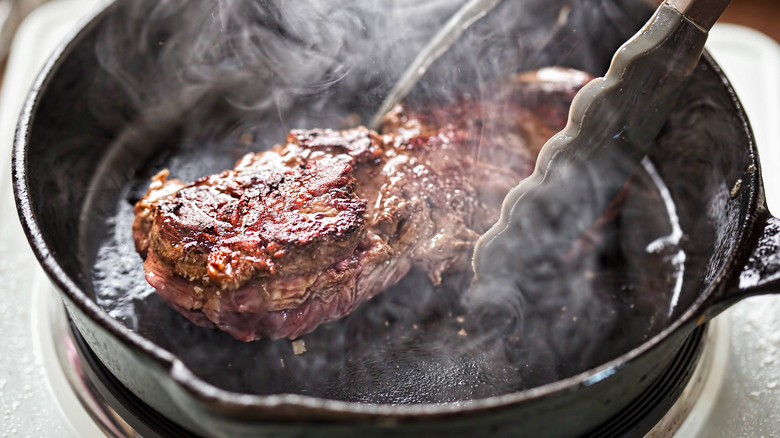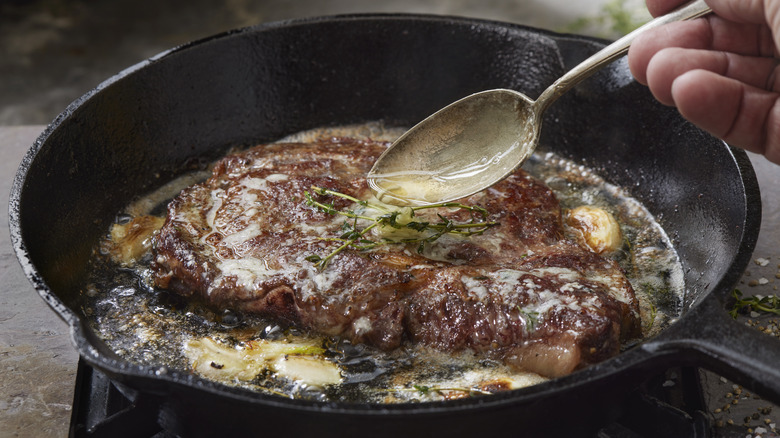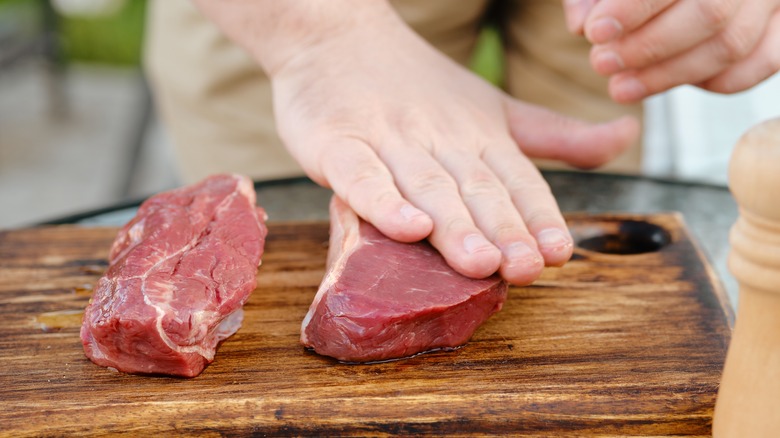The Oil Mistake Everyone Makes When Cooking Steak
High heat is a must when searing the perfect steak, creating a brown and crusty outside with tender, juicy meat within. However, some cooks hesitate to use a ripping-hot pan, especially if it tends to fill the kitchen with smoke. If you're familiar with this scenario, chances are that the oil you use is to blame, not the high heat itself.
Using the wrong type of oil is one of the most underrated mistakes to avoid while cooking steak. It all has to do with the smoke point of the oil, or the temperature at which it starts smoking and burning. For instance, you might like using extra-virgin olive oil in the kitchen, but it has a relatively low smoke point of 325 degrees Fahrenheit. If you heat it to the temperature required to get a nice crust on a steak – at least 375 degrees Fahrenheit, and ideally hotter – it will produce fumes and smoke up your kitchen, while adding a burnt taste to the meat.
On the other hand, rice bran oil can be heated to 490 degrees Fahrenheit before it begins to burn, making it excellent for cooking steak. You'll likely still see some smoke rising out of the pan, but not so much that it sets off your smoke alarm or gives your dinner an acrid taste. Choosing the right oil not only makes the cooking process easier, but it can also enhance the flavor of the meat, depending on which type you use.
The best types of oils to use for cooking steak
Any high-heat oil that's perfect for sautéing will work well for steak. Seek out one that can withstand at least 400 degrees Fahrenheit. Vegetable oil has a smoke point of around 450 degrees Fahrenheit, and both sunflower and corn oil have similar smoke points. If you're not afraid of high heat and cook your steak super hot for a deep crust on a rare interior, try safflower oil, which can be heated to a whopping 510 degrees Fahrenheit before it burns.
Extra-virgin olive oil should be avoided for steak, but you can try light or refined olive oil, which won't smoke until it reaches around 465 degrees Fahrenheit. And even though butter gives a deliciously rich taste to red meat, it has a low smoke point of just 350 degrees Fahrenheit, so it isn't ideal for cooking steak — unless you clarify it. Once clarified, which removes milk solids that burn easily, butter can be heated to 450 degrees Fahrenheit.
If you want the meatiest flavor possible, go to the butcher shop and ask for beef tallow, which is the secret to restaurant-quality steaks and side dishes. Tallow is pure beef fat that has a high smoke point of around 400 degrees Fahrenheit. It imparts a deliciously rich, savory, extra-beefy flavor to the meat, as well as potatoes or other veggies you might want to roast to go with it.
Oil the steak instead of the pan to avoid more smoke
Choosing the right oil is the first step to a less stressful, more dependable steak experience, but using the correct amount is also key. If you use too little oil, the steak might stick to your skillet (although it shouldn't if the temperature is hot enough), but heat up a big pool of oil, and it might spit and smoke, even if it has a high smoke point. This can not only make your time in the kitchen dangerous, but the finished steak will turn unpleasantly greasy.
The best way to use oil is to add it directly to the steak, rather than into the pan. Simply drizzle your chosen oil onto both sides of the meat, rubbing it in with your fingers or a basting brush. You only need to use a little oil to coat the steak: A tablespoon or two should be enough, depending on the size of the cut. Oiling the meat instead of the pan also ensures that you don't overheat the oil. Even a few seconds too long can make for a splattering, smoky situation.
Oiling the steak also helps seasonings stick better to the meat's surface. Add a generous amount of salt to each side right before the steak hits the pre-heated pan, and the combination of oil and salt will help it develop a beautifully browned and tasty crust.



